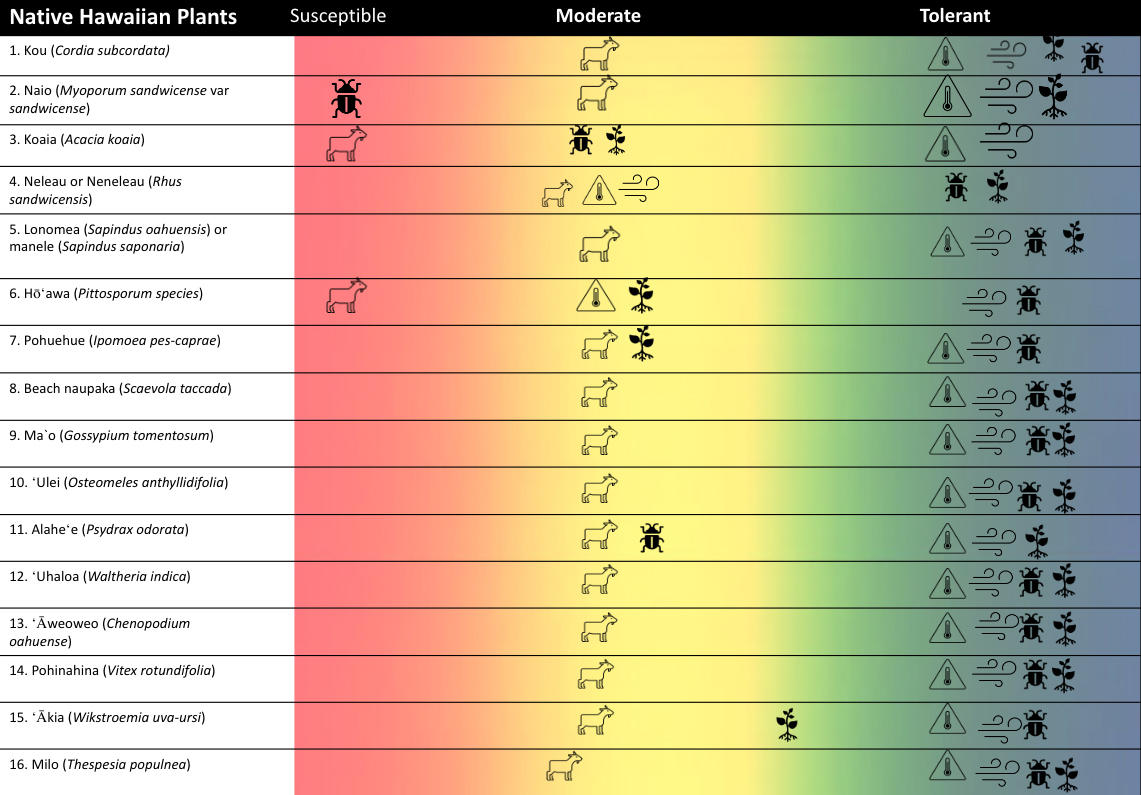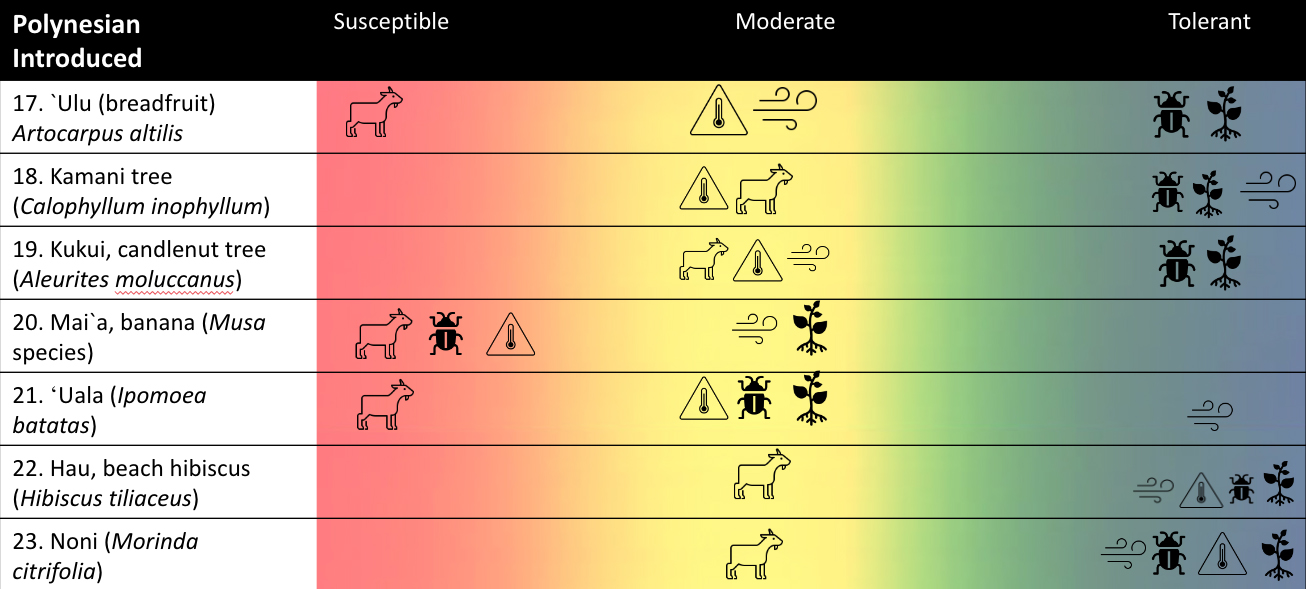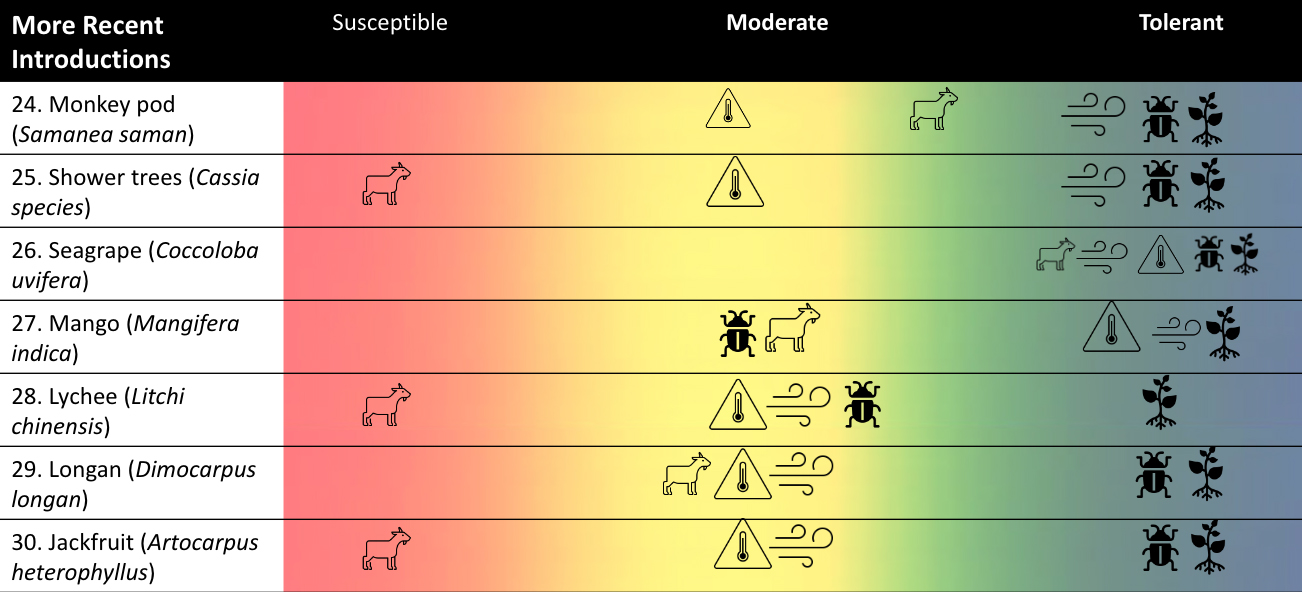Coastal Plants for Creating Green Breaks
Plant Hardiness for Green Firebreaks
Survey Results & Discussion
Sixty-five respondents evaluated each of the 30 species' as being susceptible (-1), moderately tolerant (0), tolerant (1) or extremely tolerant (2) to five environmental stressors: drought, heat and/or wind, pests and pathogens, weed competition, and resistance (palatability) to browsing animals (such as goats, deer, etc). All respondents self-identified as having either "extensive (over many years)" or "moderate" experience in Hawaiian native ecosystem restoration and/or commercial landscaping. For each species, we used the median score from all respondents for each stressor to summarize species tolerances in the graphic below. We also asked respondents to suggest additional species for consideration (listed below). Survey data can be downloaded here. Comments and descriptions for individual species, along with complete survey results can be found by clicking on the species name below >> READ MORE HERE
Native Hawaiian Plants

Polynesian Introduced Plants

More Recently Introduced Plants

Other Notable Species
Respondents were also asked to include and evaluate for hardiness up to three additional ground cover, shrub and tree species. Notable native and indigenous species included the following:
- Cordyline fruticose (kī, ti, ti leaf); susceptible to ungulates
- Dodonaea viscosa (a‘ali‘i); very hardy, potentially low plant moisture
- Erythrina sandwicensis (wiliwili); drops leaves in dry season
- Fimbristylis cymosa (mauʻu ʻakiʻaki); smaller stature than many nonnative grasses
- Jaquemontia ovalifolia subsp. sandwicense (pā’ūohi’iaka)
- Heteropogon contortus (pili grass)
- Plumbago zeylanica (ʻilieʻe)
- Sesuvium portulacastrum (akulikuli)
- Vigna marina (nanea)
Other more recently introduced plants included the following:
- Agave species; used for green firebreaks in South America
- Ananas comosus (Pineapple); used for green firebreaks in South America
- Cajanus cajan (Pigeon pea); may outcompete grasses
- Delonix regia (Royal poinciana)
- Colvillea racemosa; drought tolerant
- Gardenia taitensis (Tahitian gardenia)
- Guaiacum officinale (Lignum vitae); slow growth, but tolerant of coastal conditions
- Heliotropium arboreum (Beach heliotrope)
- Plumeria pudica; this species does not drop leaves
- Pongamia pinnata; works well in Palau
- Sanseveria species
- Schotia brachypetala; drought tolerant
- Terminalia catappa (Tropical almond or false kamani)
Caveats
It is important to note the following regarding the scope and results of this survey:
- The results serve as a working list which has not yet been verified either experimentally nor in the scientific literature. For example, plant traits such as palatability to ungulates have not been tested as part of this survey. Other traits that could contribute to a species' resilience (such as resistance to flammability) or competitive advantage (if it has allelopathic traits for example) have not been assessed.
- For species-specific information on drought tolerance in a given locale, consult the Drought Tolerance Index or the University of Hawai‘i publication Salt and Wind Tolerance of Landscape Plants for Hawai‘i.
- This list of species is not meant to replace site-specific planting or stewardship plans. It is important to choose species which are specific to your island locale, elevation, moisture regime. For Hawaiian native species, consult the Laukahi Network and Mapping Plant Species Ranges in the Hawaiian Islands (2007).
- Other considerations for ensuring the success of long-term restoration of green breaks include articulating a clear purpose (is this for home landscaping, agroforestry, reforestation?), understanding the land ownership (private or public) and ensuring that funding and agreements with landowner are in place.
- Proper site preparation and a moderate level of maintenance is essential to success. For example, fencing the site to prevent browsing by goats, deer, sheep or pigs is critical to the success of any vegetation restoration project. While we have focused on plants requiring less care and maintenance, many respondents said that one can't simply out-plant and then walk away. Thriving green breaks are a function of one's long-term commitment to the project, especially within the first year. >> READ MORE
- Species in this survey aren't meant to address short-term soil stabilization needs. For soil stabilizing actions >> READ MORE
Additional Research Is Needed
Additional research on these and other species could include the following:
- determining comparative growth rates among different species for outplanting;
- determining success in creating canopy cover for shading effects;
- understanding competitive ability among weedy plants (like grasses);
- comparing relative success on different irrigation regimes (such as on or off irrigation);
- documenting litter production as a contributing fuel hazard.
Other considerations for plant hardiness vis-a-vis fire might be to:
- consider the structure of the plant (i.e., whether its growth form includes a lot of ladder fuels at its base versus a more vertical, column like structure);
- determine whether the plant produces lot of (flammable) resin;
- determine if a species is fire resistant (recovers after fire) vs. fire adapted (requires fire as part of its life cycle).
If you have additional research needs or ideas, please >>SUBMIT THEM HERE.




